Introduction

At this exact time last year I was still in email limbo with Fractal Design, as I was trying to obtain samples and see what all the hype surrounding their products were all about. In the short span of only a year I got to look at quite a few of their cases as well as a fan controller they released not too long ago. In that time I have come to not only like the white accented black chassis designs, but have come to revere them for their sturdy construction and solid build quality. Every chassis I have seen, whether small or large, have always delivered a chassis worth owning.
We all knew about the Arc series, and of course there was the Define series that covered a few of the more popular designs over the past couple of years, but we are introducing a whole new series today. With most of the chassis designs being a regular tower configuration, most of what I have seen has been almost a direct evolution from one design to the next. Delving into the SFF chassis world for the first time, Fractal Design had no real blueprint to work from, but from what I have seen in the past, it makes me eager to see what they have in store this time around.
The SFF chassis in question today is the Node 304, one of two cases currently offered in this series. There is a larger Node chassis that is more of an HTPC design and will allow for full ATX motherboards inside of it with the Node 604. While these two cases do share a few features, the chassis layout is completely different between the 604 and the Mini-ITX compatible Node 304. Things like front mounting a PSU and using a power extension cable, modular hard drive racks, and eliminating the ODD bays to give a very clean aesthetic appeal are just some of the features to be found.
If your interest is piqued and you want to see more, continue with us as I shed light on what the new Node 304 is all about.
Specifications, Availability and Pricing
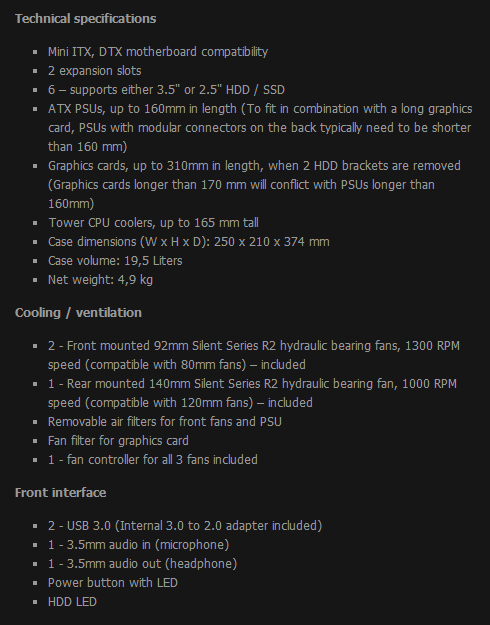
The Node 304 is comprised mostly of steel for the majority of the frame and panels. There is a bit of ABS plastic used for the frame of the front bezel. The last choice of materials was to place brushed aluminum that is anodized black to match the chassis and is used to dress up the front of the Node 304 as it completely covers the plastic component of the front bezel. Since there is no optical bay in the bezel, Fractal Design went with the completely clean look, and all ventilation for the chassis is on the top and bottom of the bezel, both sides of the chassis, and of course the rear of the chassis offers exhaust ventilation.
Moving over to the feature set, the front I/O offers native USB 3.0 with a USB 2.0 adapter built in and HD audio 3.5mm jacks. Behind a pair of 92mm Silent Series fans you will find new drive trays inside. These are dual drive racks that will fit both 2.5" and 3.5" drives for a total of six bays. Along with the motherboard tray that will house a DTX or Mini-ITX motherboard, you can also find a 140mm fan in the back, two expansion slots, and a built in fan controller that can control three fans. What is also nice about this design is that there is room enough to install a tower cooler as long as it is shorter than 165mm tall. If you use the right length PSU, and 160mm is recommended, you are then left with 310mm worth of room for a video card inside of this SFF design.
Even though the Node series is relatively new to the market, I was still able to locate quite a few places currently showing stock. On the low end of the pricing is NextWarehouse.com with a price just north of $90 and that is to your door. On the higher end of the spectrum is Newegg with a $104.98 price with shipping included.
As of this moment I can say things look really promising for the Node 304. Let's dig a little deeper, shall we?
Packaging
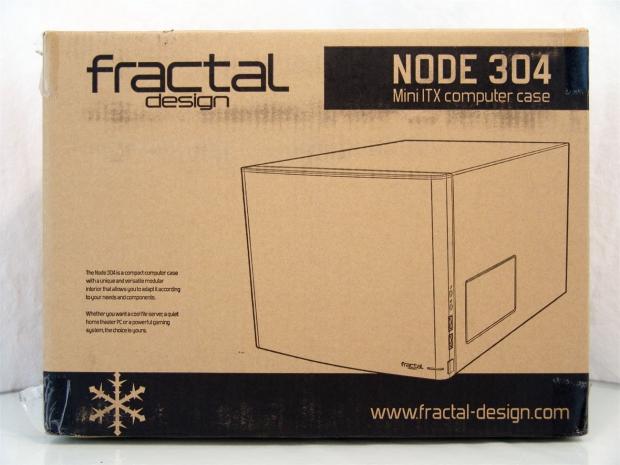
To help keep all the cost of this purchase in what you actually use, the packaging is plain brown cardboard with black print over it. On the front it offers a rendering of the chassis to the right under the naming, and off to the left is a little bit of text explaining the concept.
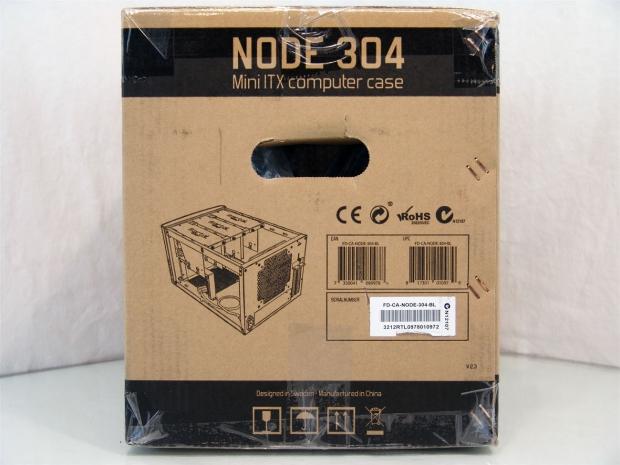
On the right side there is a rendering of the Node 304 without the top and side panels on it. Aside from that there are a couple of bar codes and the part and serial numbers found here.

Around back there is a list of eight features off to the left covering everything from style queues all the way to the fan controller in the back. This panel also offers an exploded look at the chassis with all of the components visible in the rendering.
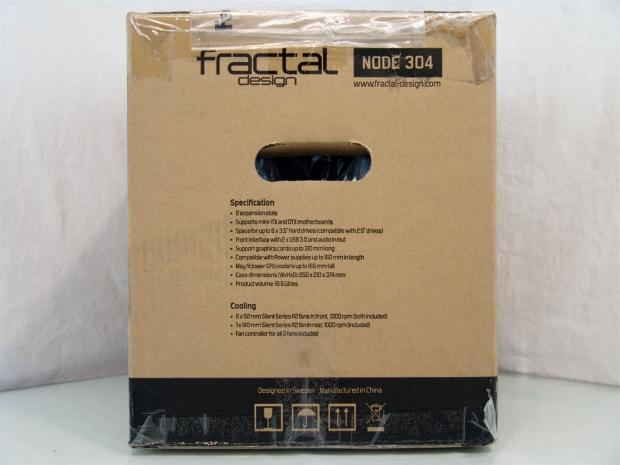
The last panel offers the company name and chassis name as did all the other sides. The new information found here are the specifications lists for both the chassis and the fans that keep the interior cooled.

The Node 304 is currently on its side, but this is how it is oriented inside of the box. With the top of the chassis pointing to the left, technically the top and bottom of the chassis have the Styrofoam placed on them to protect the chassis. As an extra step, and something to protect the aluminum front is the plastic liner that will keep the foam from rubbing on the case and marring the finish.
Fractal Design Node 304 Mini-ITX Chassis
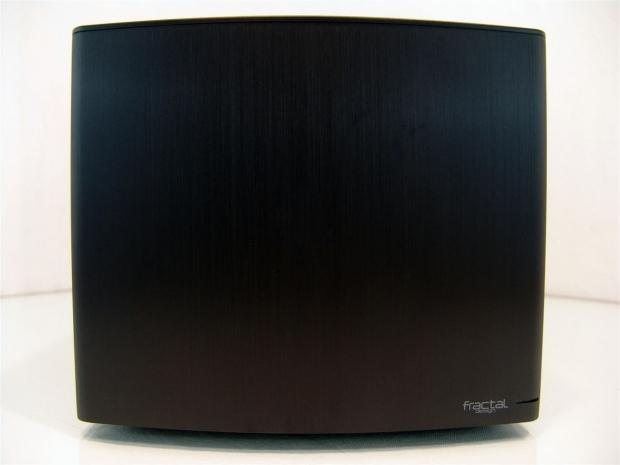
The front of the Node 304 is basically just this curved expanse of anodized aluminium. While the surface is brushed, the only thing that even attracts the eye is the small white Fractal Design naming next to the power LED lighting slit that allows users to see the light from the front of the chassis.
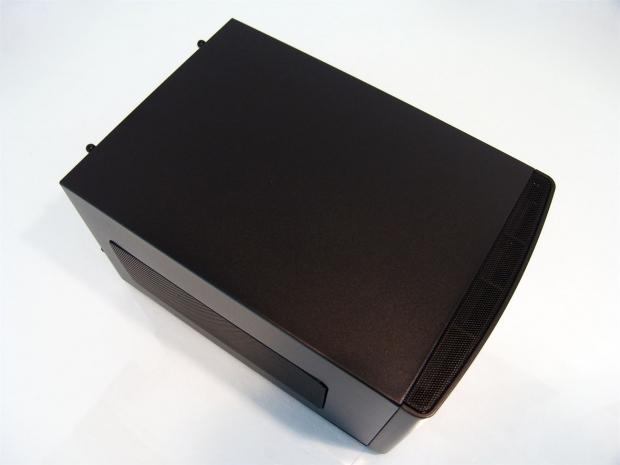
The top of the chassis has a wide ventilated area on the bezel to allow air in for the intake fans. As for the top of the chassis, it is solid without any ventilation.
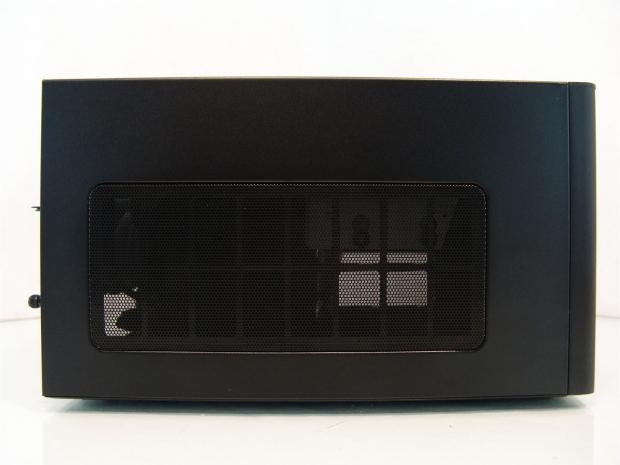
The left side of the chassis offers a very large removable filter that can be popped out and cleaned so that any video card drawing air through it can have access to free flowing cooler air.

In the back of the chassis Fractal Design has placed a 140mm fan to rid the chassis of heat, and if you look closely at the top right corner, you can see the three position fan controller. At the bottom there is the PSU extension cable jack to plug in the cord, the rear I/O opening and two expansion slots.
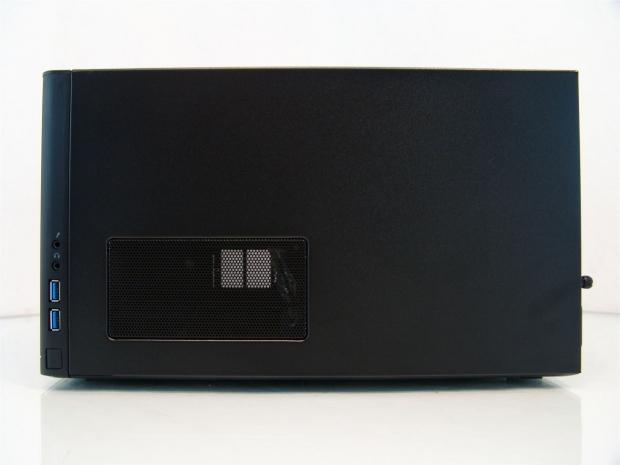
The right side of the chassis has a much smaller ventilated area provided. This ventilation is to allow the exhaust of the PSU out of the chassis. If this seems a bit confusing, wait until you see inside the Node 304, it will clear all of this up.
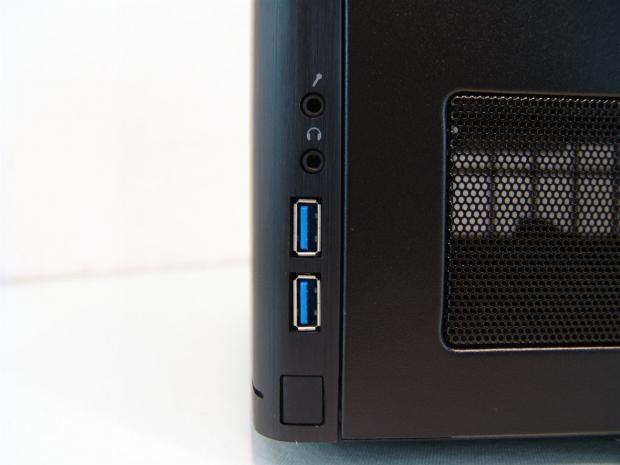
Just in front of the ventilation, on the side of the front bezel is where the front I/O is located. Here you get a power button at the bottom, two USB 3.0 ports and the headphone and microphone jacks as you work your way up the side.

Under the chassis you can see there is a thick rail that runs around the outside adding stability and strength to the chassis, as it also offers a place for the padded rubber feet that are applied here. On the left side is a very large PSU intake dust filter that can be removed easily for cleaning.
Inside the Node 304
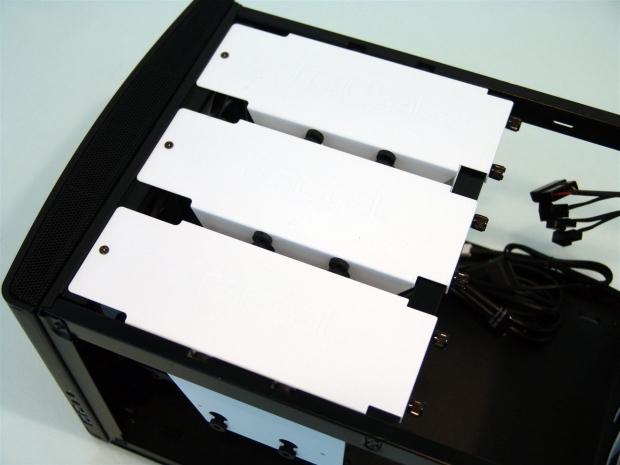
As you remove the four thumbscrews in the back, the top and sides slide back as one piece, and then you can lift it off the top of the chassis. The first things you see inside are these three modular racks for storage drives. They hold the drives inside of the metal frame and are set up to accept 2.5" and 3.5" drives.

Looking in from the left side, you see all of the wiring bundled on the floor as well as the fan controller wiring hanging from the top. Something else to notice is that the top support bar is screwed into place and can be removed to help fit things inside.
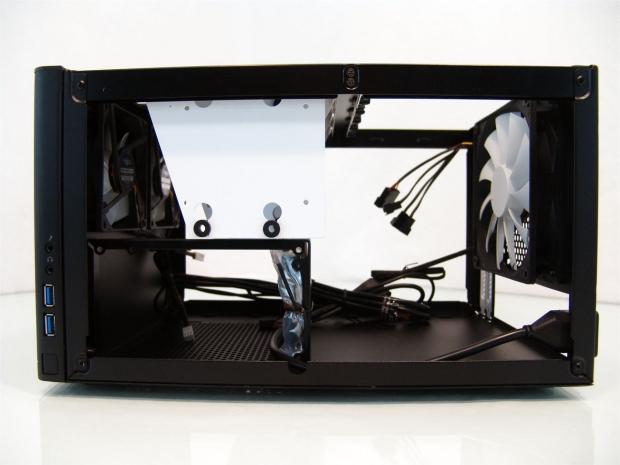
Looking in from the right side of the Node 304 shows you the PSU mounting bracket on the left. This is where you are to install the power supply, and you can make the connection to the back with the included power adapter.
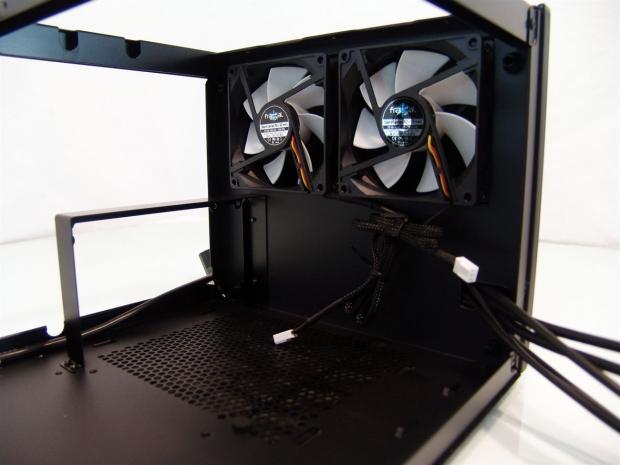
The front of the chassis, once the drive racks are removed, can be seen to hold a pair of 92mm fans that for the most part will keep the drives cool, and if you don't fill all six bays, you will have an ample supply of air to the CPU cooler and components.
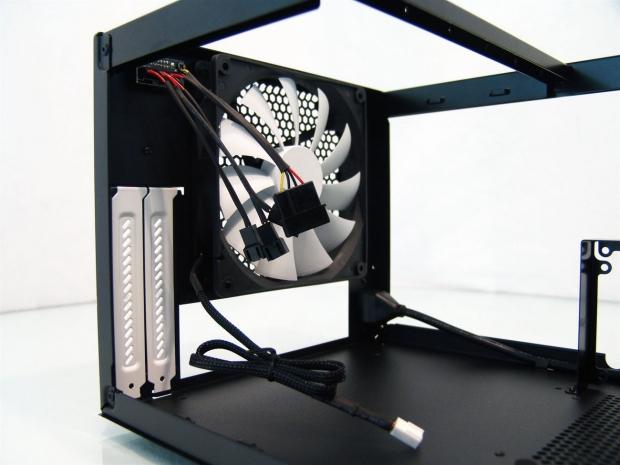
Just behind the holes in the floor for the PSU is the Mini-ITX motherboard tray. In the back of the chassis is the 140mm fan, a different look at the fan controller, and you can see you need to remove the small panel from the outside to remove the expansion slot covers.
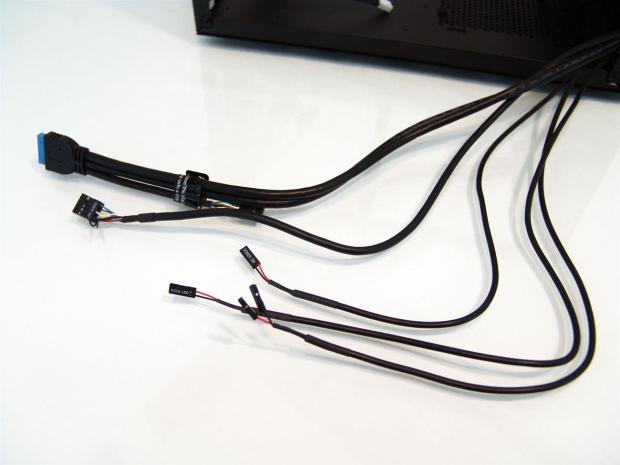
The wiring supplied with the Node 304 is all black and matches the interior well. There is quite a bit of extra length for this chassis in this wiring, and to keep the inside of the chassis looking tidy and clean, there are lots of tie points provided, but you may need to get creative with the extra wiring.
Accessories and Documentation
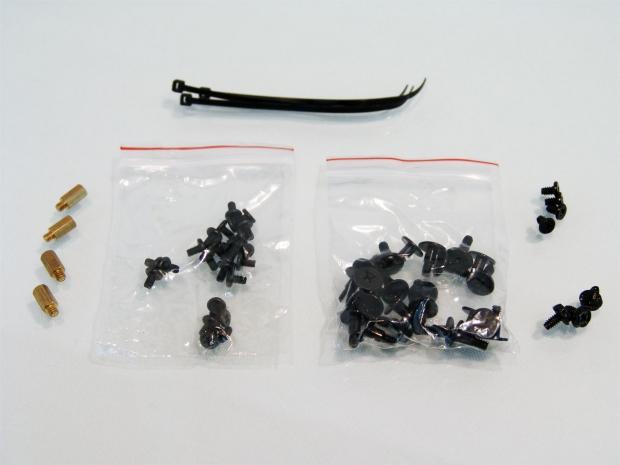
To find the hardware, it is located tied to the PSU support frame inside the chassis. Inside of a larger bag, this is what is included. There are four risers, 24 2.5" drive mounting screws, 24 3.5" drive mounting screws, four motherboard screws, three PSU screws and the three wire ties at the top.
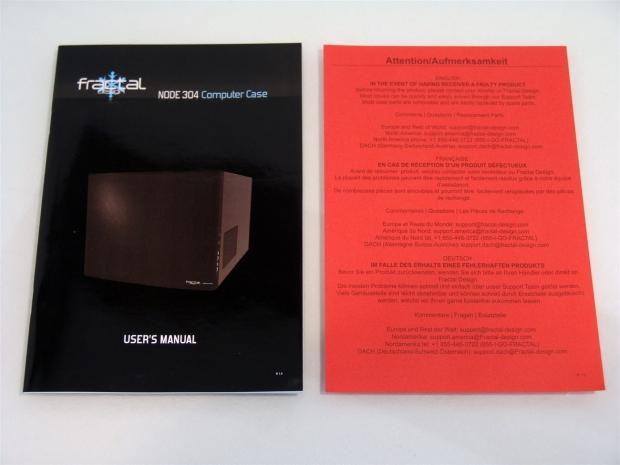
Inside of a much larger bag, and shipped outside of the chassis, there is the user manual for the Node 304 along with a red insert. This insert states that if you do happen to have a damaged or faulty part, please contact the manufacturer and don't return it to the point of purchase to have the situation fixed, and they have supplied the information to make this happen as fluently as possible.
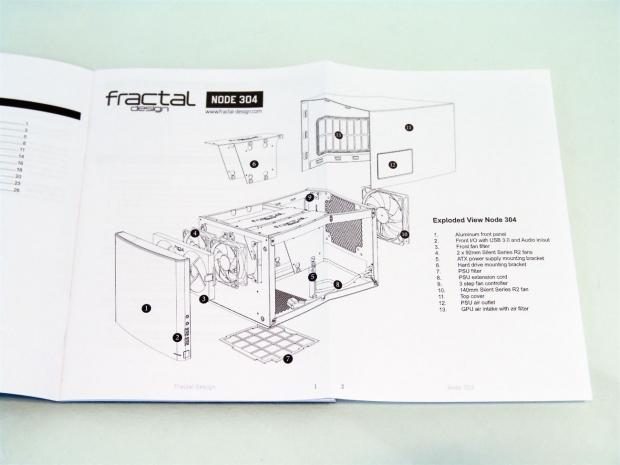
Inside of the manual there is a fold out page that numbers all of the parts in this exploded view of the Node 304 with the description of all of the parts to the right of the rendering.

As for the rest of the manual, it is all text based. They start off with the story of this specific chassis, and then jumps right into the steps associated with the installation.

It continues on through the steps on the next page, and winds up discussing the warranty period of two years. The book is quite thick, but covers many languages as it continues, and is why there is only the one images, as to add them along with the text would have taken much more manual to get it done, and this way saves you some money as well.
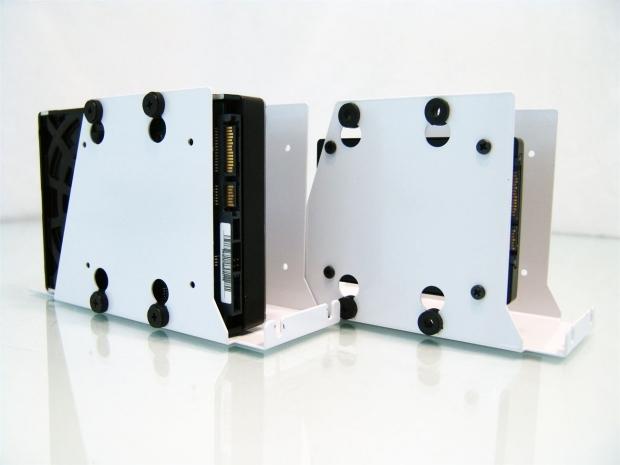
The last thing I want to show you before I get into the build images was the modular drive bays. Removing one screw and loosening two thumbscrews will allow each bay to lift out of the top of the chassis. These trays are designed to hold a drive inside of either metal side and are drilled for 2.5" drives as you see on the right. For the 3.5" drive installation, you send screws through the grommets to isolate any vibrations.
The Build and Finished Product
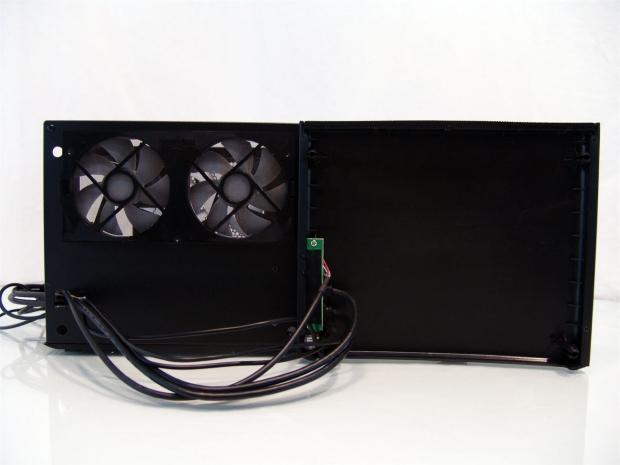
Removing the front bezel isn't needed for the optical bay because there isn't one. What you do gain access to here is all of the extra cabling from the front I/O, and you can also remove the front dust filter this way for cleaning.
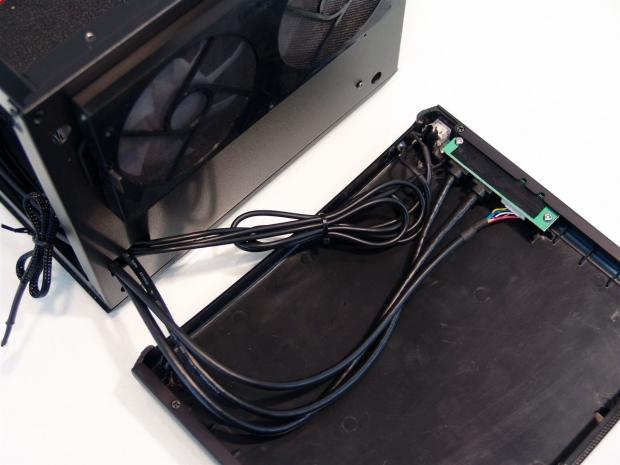
After I connected the wiring from the I/O panel I went ahead and pulled the extra wiring forward and left it low as not to block the fans. This is really the only choice unless you are fine with a lot of wiring inside the chassis.
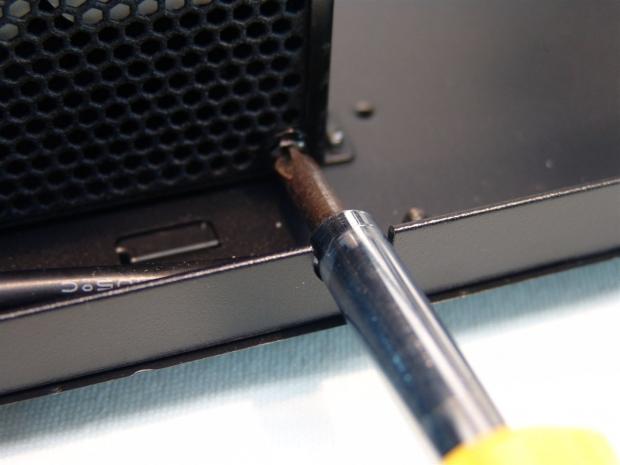
I didn't notice this at first, but due to the low height of the PSU screw, there is a cut away in the frame that allows you to get a screwdriver into the correct position to fit the screw.
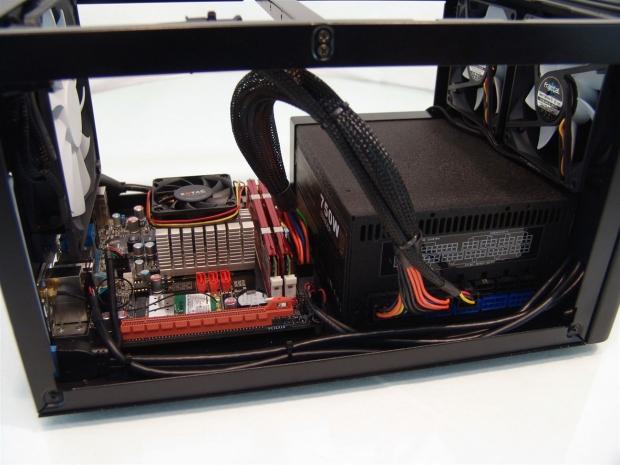
Before things get too full I figured I should take an image showing how well even this larger PSU fits, and how much room is allotted to house the motherboard in. Things are cramped, and my PSU is a bit long, but with this setup, I have all the room I need.
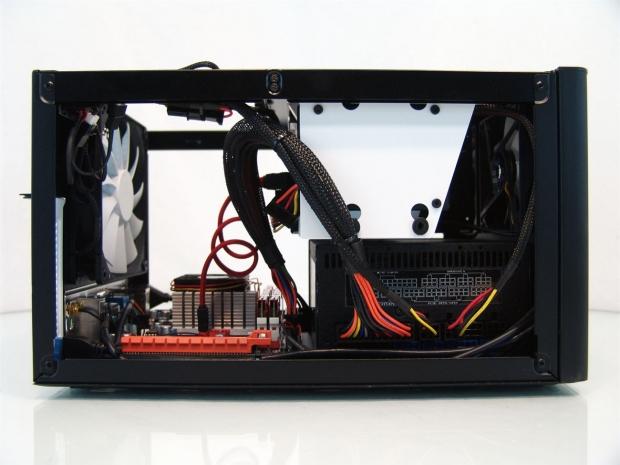
All finished up with the wiring, and I have the bays for the storage drives back in place. Besides struggling to screw in the risers to the floor of the chassis, the build went pretty effortlessly. Due to the length of this PSU I was not able to use a video card.
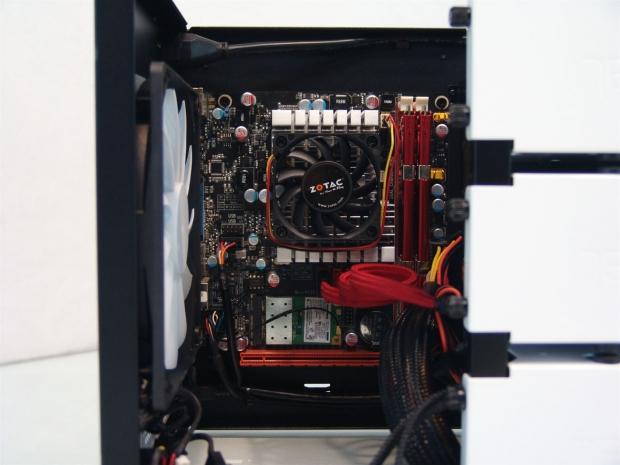
Even with the tight confines this design leaves inside of the Node 304, you can see that a tower cooler can easily fit and that the support bar and drive bays shouldn't interfere.

The rear dust shield snapped right into place and without the power supply in the chassis I did fit the card in the slots to check out the alignment and I was even able to fit in the HD 7950.
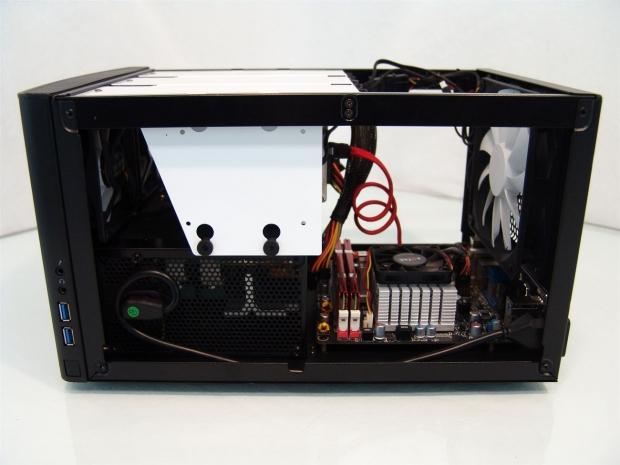
From this side, you can see I now have the adapter for the PSU plugged into the unit so that I can power it from the plug in the back of the chassis. There is also plenty of room for access to swap out memory or remove the CPU cooler fan for cleaning. With the installation completed I reinstalled the one piece cover and you are left with a Node 304 that looks very much as it did when we removed it from the packaging.
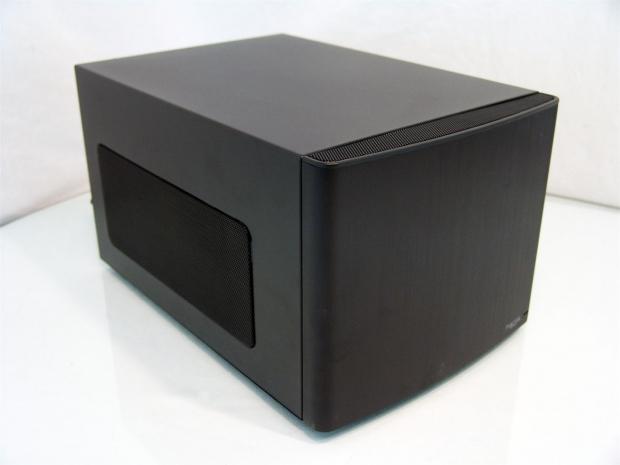
With the cord attached and the system booting, you get the glow of blue LED coming out of the slit on the front bezel denoting system power is on. Just under the "a" in Fractal you can also see a white LED glowing as it accesses the storage drive inside the chassis.
Final Thoughts
As with anything else Fractal Design has delivered in chassis design in the past, the Node 304 is very sturdy, and even when empty, it is surprisingly weighty. Once you get through the build process and go to move this compact chassis around, the weight is even more of a surprise. This is mainly due to the over building of the chassis frame to give it a very stable structure even with the top of the chassis removed. Even when I removed the center support bar, the chassis was still in square and didn't distort. As for the features included with the Node 304, you get everything one needs. It offers USB 3.0 ready to go back to USB 2.0 if needed, a sleek looking exterior, removable dust filters, and plenty of ventilation. As long as you play by the rules with the PSU size limitations, the Node 304 can encompass a very powerful system. The only thing I find lacking is an easy way to carry this small piece of work to a LAN event, as I am sure outside of maybe an HTPC, or a space saving desktop rig, that is where most of these cases are going to be used.
I really liked the fact that you get three fans in the chassis out of the box. The pair of 92mm intake fans provides plenty of air flow to the CPU and the drives hanging in the modular bays. Combined with the three fan controller built into the chassis, users can define what is comfortable for their environment. With the switch set to "L" for low, there isn't any noise you can hear outside of a foot away from the chassis, and the feel of the flow to the hand is very low. What is really nice is that even when set to the "H" position, the high speed of the Silent Series R2 fans even within a foot of the chassis there is a minimal hum heard near the chassis. Outside of three feet from the chassis I could not hear it at all.
I have seen quite a few of these Mini-ITX SFF chassis designs, and to tell you the truth, while not being a BitFenix Prodigy killer, the Node 304 does stand its ground. It may not offer water cooling compatibility, but the sleek looks, innovative interior, and the compact design all has its merits. The real issue I have is no matter how much I like this design, the Prodigy is also right at this same price point. If you want the elegance of a Lian Li or a Silverstone chassis without that serious price tag, the Node 304 fits that bill and definitely has its place in the market.
That all being said, I still do like the Node 304 very much, even with the limitations it poses on components used. For $90.85 there are other solutions out there, but none that look this sleek and simple.



 United
States: Find other tech and computer products like this
over at
United
States: Find other tech and computer products like this
over at  United
Kingdom: Find other tech and computer products like this
over at
United
Kingdom: Find other tech and computer products like this
over at  Australia:
Find other tech and computer products like this over at
Australia:
Find other tech and computer products like this over at  Canada:
Find other tech and computer products like this over at
Canada:
Find other tech and computer products like this over at  Deutschland:
Finde andere Technik- und Computerprodukte wie dieses auf
Deutschland:
Finde andere Technik- und Computerprodukte wie dieses auf